Detailed Technical Report: Single-Storey Building Design and Analysis
VerifiedAdded on 2021/06/14
|8
|1942
|281
Report
AI Summary
This technical report provides a detailed analysis of the structural and technical requirements for a single-storey residential building. It examines both primary structural elements, such as foundations, walls, floors, and roofs, and secondary elements, including subfloor barriers, rain screens, and internal partitions. The report emphasizes the importance of compliance with building codes, particularly BCA Volume 2, and addresses function and performance attributes of each element. It covers site preparation, including earthworks, drainage, and termite management, as well as footing and slab design, considering soil conditions and forces from wind, solar radiation, and storm water. The report also discusses the impact of earthquakes and other natural forces, and proposes granny flats as a sustainable design integration. Finally, it differentiates between structure and form in the context of construction engineering, concluding with a comprehensive overview of structural design details and compliance with building standards.
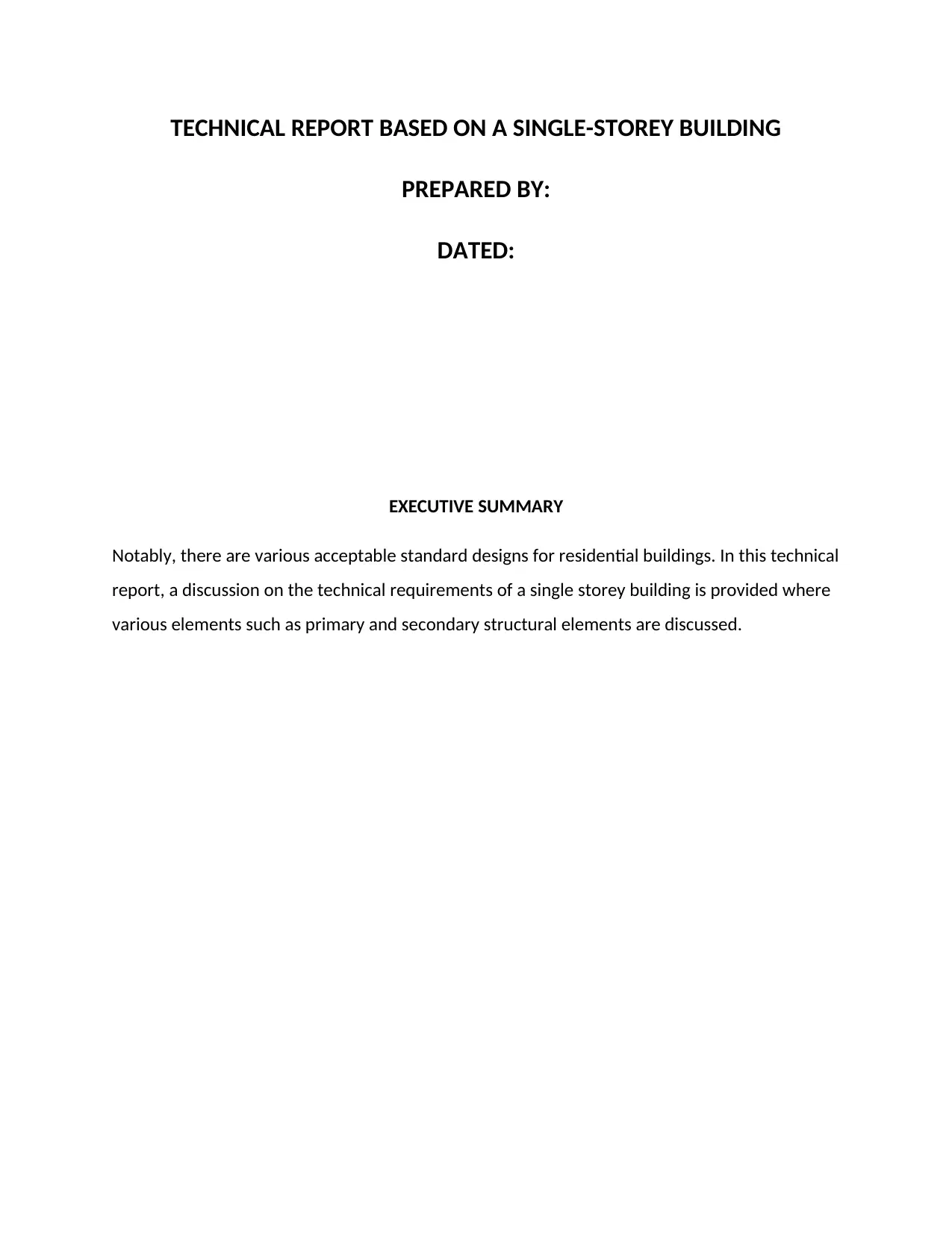
TECHNICAL REPORT BASED ON A SINGLE-STOREY BUILDING
PREPARED BY:
DATED:
EXECUTIVE SUMMARY
Notably, there are various acceptable standard designs for residential buildings. In this technical
report, a discussion on the technical requirements of a single storey building is provided where
various elements such as primary and secondary structural elements are discussed.
PREPARED BY:
DATED:
EXECUTIVE SUMMARY
Notably, there are various acceptable standard designs for residential buildings. In this technical
report, a discussion on the technical requirements of a single storey building is provided where
various elements such as primary and secondary structural elements are discussed.
Paraphrase This Document
Need a fresh take? Get an instant paraphrase of this document with our AI Paraphraser

1. INTRODUCTION
Most residential buildings are designed for occupants’ long term experience. Notably, there are
various acceptable standard designs for these kinds of buildings. In this technical report, a
discussion on the technical requirements of a single storey building is provided where various
elements such as primary and secondary structural elements are discussed. It should be noted
that the dominating building code shall be BCA volume 2 and the plumbing code of Australia.
The building selected for consideration is a single storey residential building mostly designed for
an average size family. It is integrated with a number of essential services including HVAC, fire
safety among others as shall be discussed. Notably, the objective of this report is to present
both technical and nontechnical details often involved in the sustainable building design
pursuant to various clauses contained in the selected codes and standards. Hence as shown in
figure 1, granny flats were selected for consideration in the assessment report.
Figure 1: Granny flats (image courtesy of NSW Government, 2011)
Most residential buildings are designed for occupants’ long term experience. Notably, there are
various acceptable standard designs for these kinds of buildings. In this technical report, a
discussion on the technical requirements of a single storey building is provided where various
elements such as primary and secondary structural elements are discussed. It should be noted
that the dominating building code shall be BCA volume 2 and the plumbing code of Australia.
The building selected for consideration is a single storey residential building mostly designed for
an average size family. It is integrated with a number of essential services including HVAC, fire
safety among others as shall be discussed. Notably, the objective of this report is to present
both technical and nontechnical details often involved in the sustainable building design
pursuant to various clauses contained in the selected codes and standards. Hence as shown in
figure 1, granny flats were selected for consideration in the assessment report.
Figure 1: Granny flats (image courtesy of NSW Government, 2011)
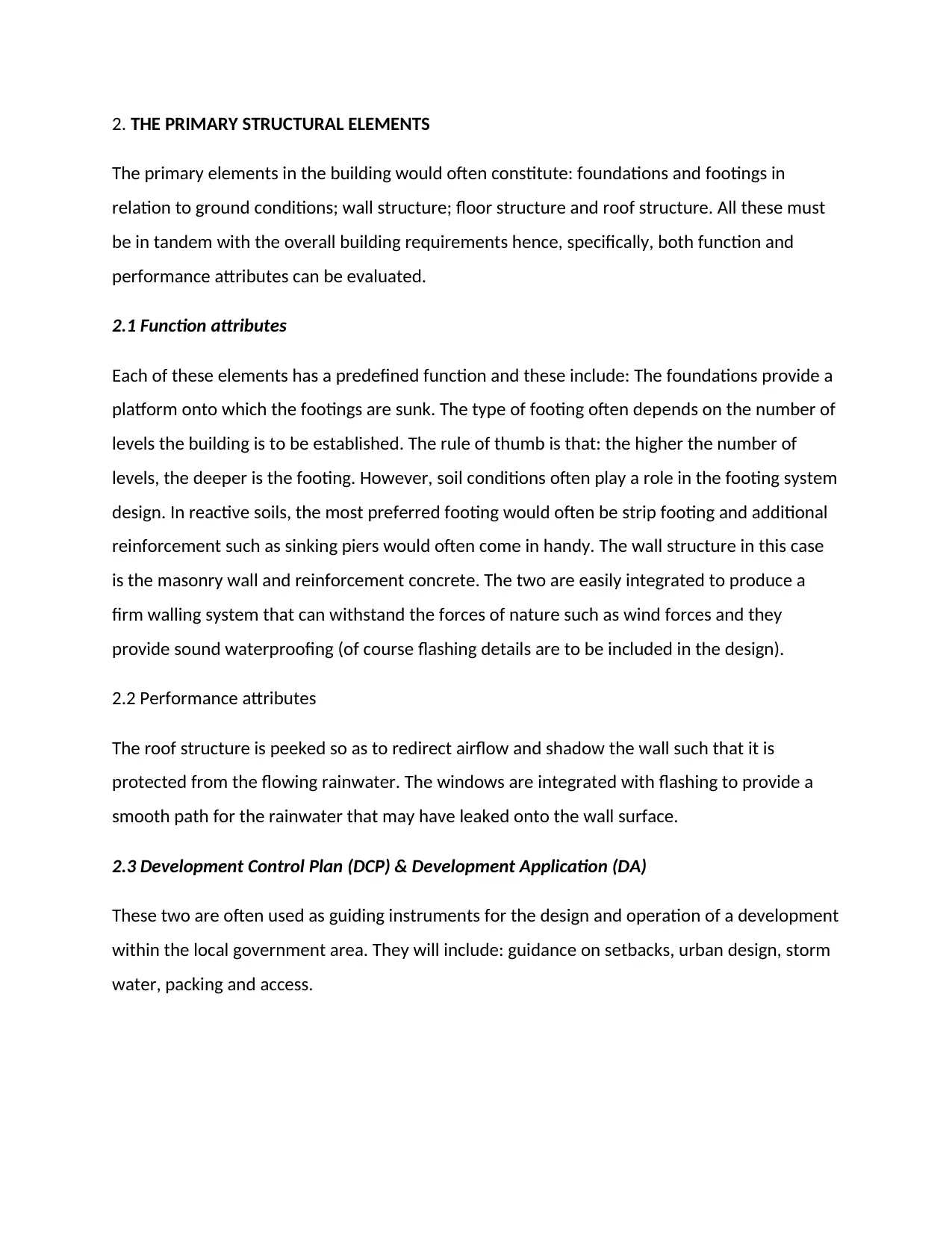
2. THE PRIMARY STRUCTURAL ELEMENTS
The primary elements in the building would often constitute: foundations and footings in
relation to ground conditions; wall structure; floor structure and roof structure. All these must
be in tandem with the overall building requirements hence, specifically, both function and
performance attributes can be evaluated.
2.1 Function attributes
Each of these elements has a predefined function and these include: The foundations provide a
platform onto which the footings are sunk. The type of footing often depends on the number of
levels the building is to be established. The rule of thumb is that: the higher the number of
levels, the deeper is the footing. However, soil conditions often play a role in the footing system
design. In reactive soils, the most preferred footing would often be strip footing and additional
reinforcement such as sinking piers would often come in handy. The wall structure in this case
is the masonry wall and reinforcement concrete. The two are easily integrated to produce a
firm walling system that can withstand the forces of nature such as wind forces and they
provide sound waterproofing (of course flashing details are to be included in the design).
2.2 Performance attributes
The roof structure is peeked so as to redirect airflow and shadow the wall such that it is
protected from the flowing rainwater. The windows are integrated with flashing to provide a
smooth path for the rainwater that may have leaked onto the wall surface.
2.3 Development Control Plan (DCP) & Development Application (DA)
These two are often used as guiding instruments for the design and operation of a development
within the local government area. They will include: guidance on setbacks, urban design, storm
water, packing and access.
The primary elements in the building would often constitute: foundations and footings in
relation to ground conditions; wall structure; floor structure and roof structure. All these must
be in tandem with the overall building requirements hence, specifically, both function and
performance attributes can be evaluated.
2.1 Function attributes
Each of these elements has a predefined function and these include: The foundations provide a
platform onto which the footings are sunk. The type of footing often depends on the number of
levels the building is to be established. The rule of thumb is that: the higher the number of
levels, the deeper is the footing. However, soil conditions often play a role in the footing system
design. In reactive soils, the most preferred footing would often be strip footing and additional
reinforcement such as sinking piers would often come in handy. The wall structure in this case
is the masonry wall and reinforcement concrete. The two are easily integrated to produce a
firm walling system that can withstand the forces of nature such as wind forces and they
provide sound waterproofing (of course flashing details are to be included in the design).
2.2 Performance attributes
The roof structure is peeked so as to redirect airflow and shadow the wall such that it is
protected from the flowing rainwater. The windows are integrated with flashing to provide a
smooth path for the rainwater that may have leaked onto the wall surface.
2.3 Development Control Plan (DCP) & Development Application (DA)
These two are often used as guiding instruments for the design and operation of a development
within the local government area. They will include: guidance on setbacks, urban design, storm
water, packing and access.
⊘ This is a preview!⊘
Do you want full access?
Subscribe today to unlock all pages.

Trusted by 1+ million students worldwide
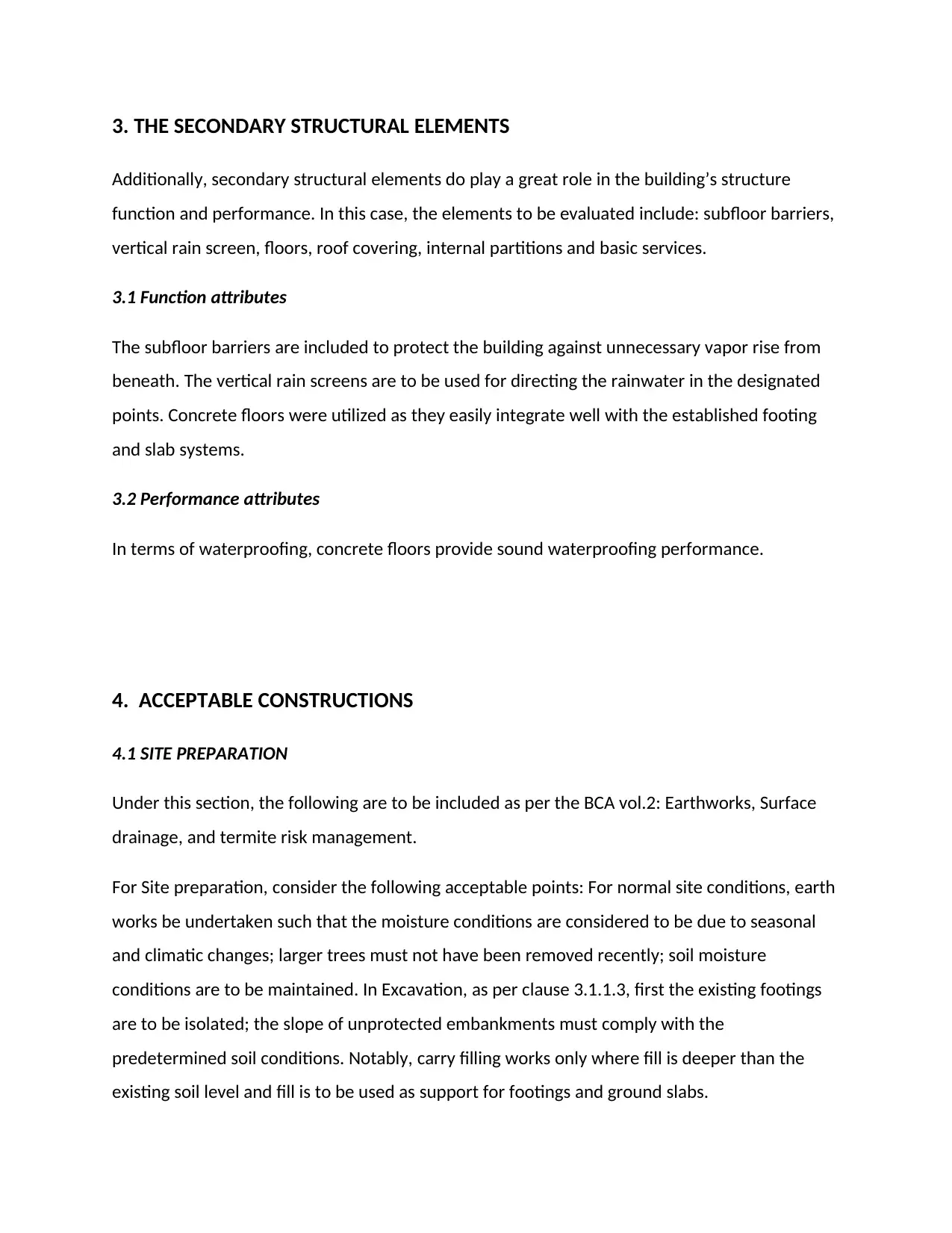
3. THE SECONDARY STRUCTURAL ELEMENTS
Additionally, secondary structural elements do play a great role in the building’s structure
function and performance. In this case, the elements to be evaluated include: subfloor barriers,
vertical rain screen, floors, roof covering, internal partitions and basic services.
3.1 Function attributes
The subfloor barriers are included to protect the building against unnecessary vapor rise from
beneath. The vertical rain screens are to be used for directing the rainwater in the designated
points. Concrete floors were utilized as they easily integrate well with the established footing
and slab systems.
3.2 Performance attributes
In terms of waterproofing, concrete floors provide sound waterproofing performance.
4. ACCEPTABLE CONSTRUCTIONS
4.1 SITE PREPARATION
Under this section, the following are to be included as per the BCA vol.2: Earthworks, Surface
drainage, and termite risk management.
For Site preparation, consider the following acceptable points: For normal site conditions, earth
works be undertaken such that the moisture conditions are considered to be due to seasonal
and climatic changes; larger trees must not have been removed recently; soil moisture
conditions are to be maintained. In Excavation, as per clause 3.1.1.3, first the existing footings
are to be isolated; the slope of unprotected embankments must comply with the
predetermined soil conditions. Notably, carry filling works only where fill is deeper than the
existing soil level and fill is to be used as support for footings and ground slabs.
Additionally, secondary structural elements do play a great role in the building’s structure
function and performance. In this case, the elements to be evaluated include: subfloor barriers,
vertical rain screen, floors, roof covering, internal partitions and basic services.
3.1 Function attributes
The subfloor barriers are included to protect the building against unnecessary vapor rise from
beneath. The vertical rain screens are to be used for directing the rainwater in the designated
points. Concrete floors were utilized as they easily integrate well with the established footing
and slab systems.
3.2 Performance attributes
In terms of waterproofing, concrete floors provide sound waterproofing performance.
4. ACCEPTABLE CONSTRUCTIONS
4.1 SITE PREPARATION
Under this section, the following are to be included as per the BCA vol.2: Earthworks, Surface
drainage, and termite risk management.
For Site preparation, consider the following acceptable points: For normal site conditions, earth
works be undertaken such that the moisture conditions are considered to be due to seasonal
and climatic changes; larger trees must not have been removed recently; soil moisture
conditions are to be maintained. In Excavation, as per clause 3.1.1.3, first the existing footings
are to be isolated; the slope of unprotected embankments must comply with the
predetermined soil conditions. Notably, carry filling works only where fill is deeper than the
existing soil level and fill is to be used as support for footings and ground slabs.
Paraphrase This Document
Need a fresh take? Get an instant paraphrase of this document with our AI Paraphraser

Secondly, for surface drainage, consider the subsoil drainage and it is to be directed away from
the area and the following are the specific requirements to go about this: graded with a
uniform fall not less than 1:300 in slope; discharge to be into an external silt pit or sump; means
of cleaning and maintenance must be provided. Importantly, however, in managing storm
water drainage, overflows must be disallowed completely from entering the building interior.
The cover to storm water drains be such that 90mm cover class 6 UPVC with under-soil
applications 100mm and concrete areas -50mm.
However it should be noted that since the building is mainly built of masonry and concrete, the
incidences of termite attack are almost zero and the provisions for termite attack is not
considered in this report.
4.2 FOOTINGS AND SLABS
The most important element, a part from the footing and slab design, is the fill material. It must
be designed, installed and tested in accordance with AS 2870. Notably, one is to grade away
from the foundation walls to fall at a minimum of 6 inches. Besides, establish the soil bearing
pressures; qualitatively, it must be strong enough to withstand the applied loads (both live and
dead). Footing must also be set below winter frost line to avoid damage from frost heave.
Concrete footings are to be included only where soil bearing pressure is below the required
standard as shall be determined by the structural engineer (Building Science Corporation, 2018).
4.3 FORCES AND THE ENVIRONMENTAL AGENTS ON THE STRUCTURES
However, notably, the building as illustrated must be under the influence of various forces and
other environmental conditions such as wind and temperature. In this section, the forces and
environment conditions influencing the structural performance of the building are evaluated.
4.3.1 Wind action
Structural resiliency as a result of wind actions is to be maintained by integrating certain design
techniques. First of all, average wind strength and direction within the site locality are to be
the area and the following are the specific requirements to go about this: graded with a
uniform fall not less than 1:300 in slope; discharge to be into an external silt pit or sump; means
of cleaning and maintenance must be provided. Importantly, however, in managing storm
water drainage, overflows must be disallowed completely from entering the building interior.
The cover to storm water drains be such that 90mm cover class 6 UPVC with under-soil
applications 100mm and concrete areas -50mm.
However it should be noted that since the building is mainly built of masonry and concrete, the
incidences of termite attack are almost zero and the provisions for termite attack is not
considered in this report.
4.2 FOOTINGS AND SLABS
The most important element, a part from the footing and slab design, is the fill material. It must
be designed, installed and tested in accordance with AS 2870. Notably, one is to grade away
from the foundation walls to fall at a minimum of 6 inches. Besides, establish the soil bearing
pressures; qualitatively, it must be strong enough to withstand the applied loads (both live and
dead). Footing must also be set below winter frost line to avoid damage from frost heave.
Concrete footings are to be included only where soil bearing pressure is below the required
standard as shall be determined by the structural engineer (Building Science Corporation, 2018).
4.3 FORCES AND THE ENVIRONMENTAL AGENTS ON THE STRUCTURES
However, notably, the building as illustrated must be under the influence of various forces and
other environmental conditions such as wind and temperature. In this section, the forces and
environment conditions influencing the structural performance of the building are evaluated.
4.3.1 Wind action
Structural resiliency as a result of wind actions is to be maintained by integrating certain design
techniques. First of all, average wind strength and direction within the site locality are to be
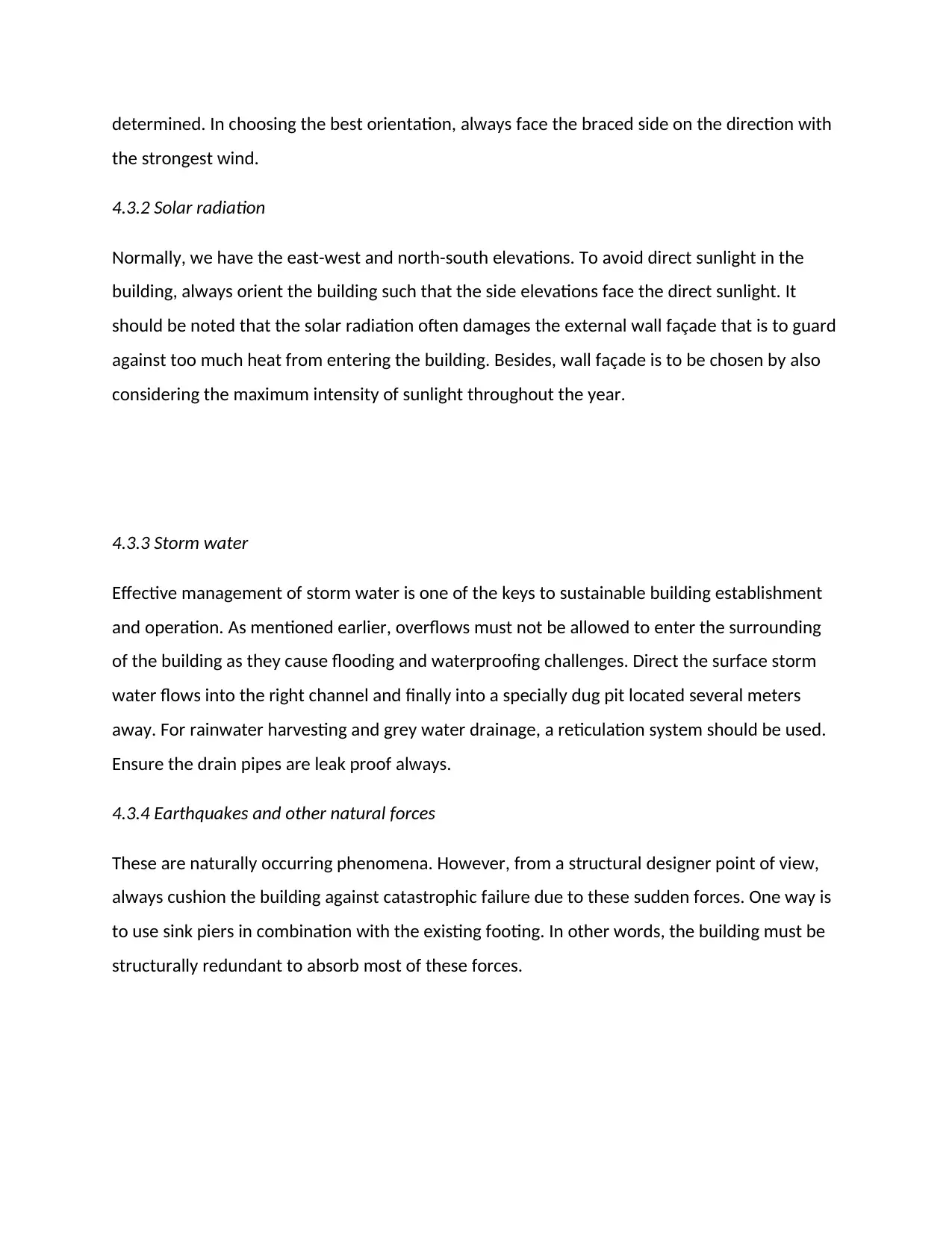
determined. In choosing the best orientation, always face the braced side on the direction with
the strongest wind.
4.3.2 Solar radiation
Normally, we have the east-west and north-south elevations. To avoid direct sunlight in the
building, always orient the building such that the side elevations face the direct sunlight. It
should be noted that the solar radiation often damages the external wall façade that is to guard
against too much heat from entering the building. Besides, wall façade is to be chosen by also
considering the maximum intensity of sunlight throughout the year.
4.3.3 Storm water
Effective management of storm water is one of the keys to sustainable building establishment
and operation. As mentioned earlier, overflows must not be allowed to enter the surrounding
of the building as they cause flooding and waterproofing challenges. Direct the surface storm
water flows into the right channel and finally into a specially dug pit located several meters
away. For rainwater harvesting and grey water drainage, a reticulation system should be used.
Ensure the drain pipes are leak proof always.
4.3.4 Earthquakes and other natural forces
These are naturally occurring phenomena. However, from a structural designer point of view,
always cushion the building against catastrophic failure due to these sudden forces. One way is
to use sink piers in combination with the existing footing. In other words, the building must be
structurally redundant to absorb most of these forces.
the strongest wind.
4.3.2 Solar radiation
Normally, we have the east-west and north-south elevations. To avoid direct sunlight in the
building, always orient the building such that the side elevations face the direct sunlight. It
should be noted that the solar radiation often damages the external wall façade that is to guard
against too much heat from entering the building. Besides, wall façade is to be chosen by also
considering the maximum intensity of sunlight throughout the year.
4.3.3 Storm water
Effective management of storm water is one of the keys to sustainable building establishment
and operation. As mentioned earlier, overflows must not be allowed to enter the surrounding
of the building as they cause flooding and waterproofing challenges. Direct the surface storm
water flows into the right channel and finally into a specially dug pit located several meters
away. For rainwater harvesting and grey water drainage, a reticulation system should be used.
Ensure the drain pipes are leak proof always.
4.3.4 Earthquakes and other natural forces
These are naturally occurring phenomena. However, from a structural designer point of view,
always cushion the building against catastrophic failure due to these sudden forces. One way is
to use sink piers in combination with the existing footing. In other words, the building must be
structurally redundant to absorb most of these forces.
⊘ This is a preview!⊘
Do you want full access?
Subscribe today to unlock all pages.

Trusted by 1+ million students worldwide
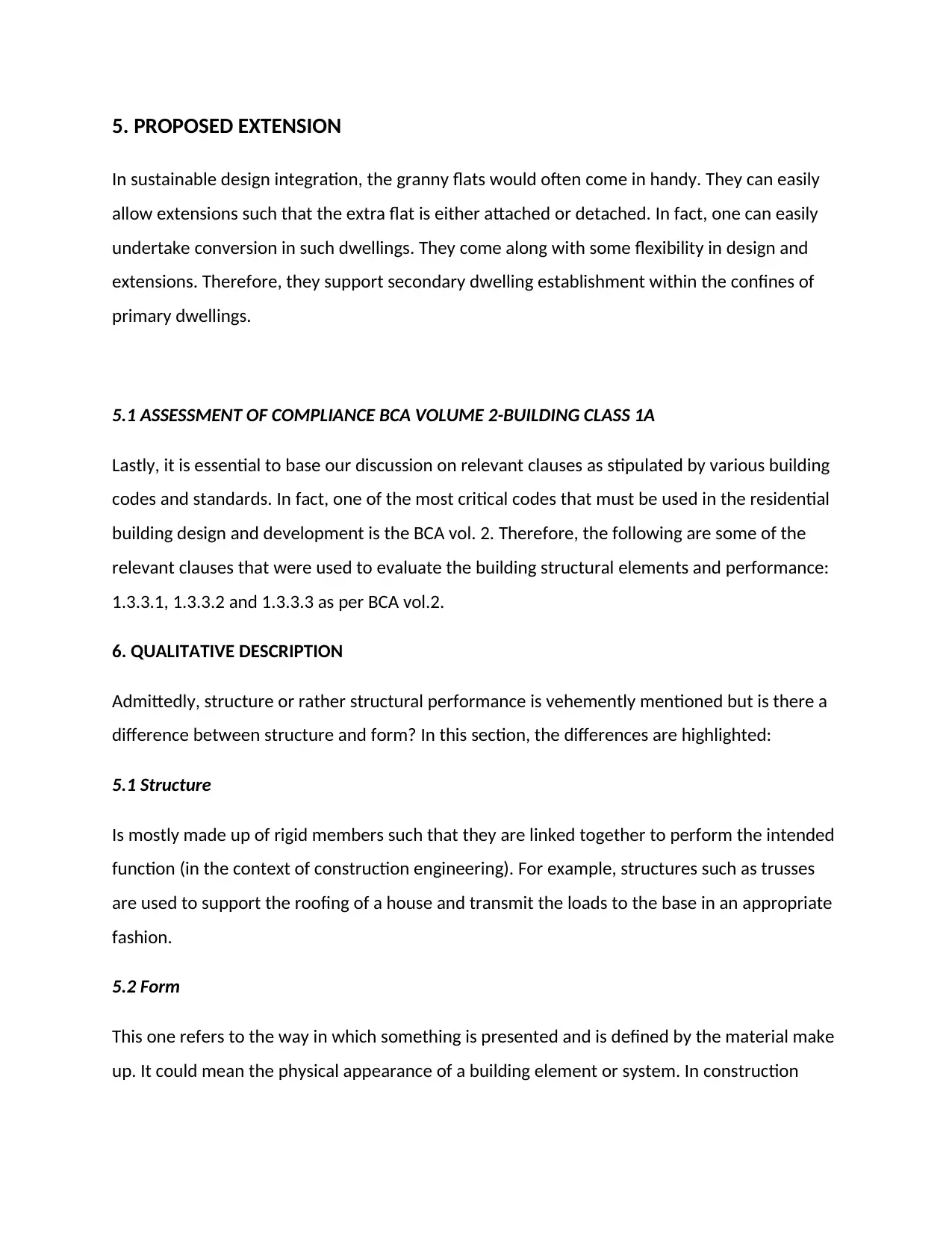
5. PROPOSED EXTENSION
In sustainable design integration, the granny flats would often come in handy. They can easily
allow extensions such that the extra flat is either attached or detached. In fact, one can easily
undertake conversion in such dwellings. They come along with some flexibility in design and
extensions. Therefore, they support secondary dwelling establishment within the confines of
primary dwellings.
5.1 ASSESSMENT OF COMPLIANCE BCA VOLUME 2-BUILDING CLASS 1A
Lastly, it is essential to base our discussion on relevant clauses as stipulated by various building
codes and standards. In fact, one of the most critical codes that must be used in the residential
building design and development is the BCA vol. 2. Therefore, the following are some of the
relevant clauses that were used to evaluate the building structural elements and performance:
1.3.3.1, 1.3.3.2 and 1.3.3.3 as per BCA vol.2.
6. QUALITATIVE DESCRIPTION
Admittedly, structure or rather structural performance is vehemently mentioned but is there a
difference between structure and form? In this section, the differences are highlighted:
5.1 Structure
Is mostly made up of rigid members such that they are linked together to perform the intended
function (in the context of construction engineering). For example, structures such as trusses
are used to support the roofing of a house and transmit the loads to the base in an appropriate
fashion.
5.2 Form
This one refers to the way in which something is presented and is defined by the material make
up. It could mean the physical appearance of a building element or system. In construction
In sustainable design integration, the granny flats would often come in handy. They can easily
allow extensions such that the extra flat is either attached or detached. In fact, one can easily
undertake conversion in such dwellings. They come along with some flexibility in design and
extensions. Therefore, they support secondary dwelling establishment within the confines of
primary dwellings.
5.1 ASSESSMENT OF COMPLIANCE BCA VOLUME 2-BUILDING CLASS 1A
Lastly, it is essential to base our discussion on relevant clauses as stipulated by various building
codes and standards. In fact, one of the most critical codes that must be used in the residential
building design and development is the BCA vol. 2. Therefore, the following are some of the
relevant clauses that were used to evaluate the building structural elements and performance:
1.3.3.1, 1.3.3.2 and 1.3.3.3 as per BCA vol.2.
6. QUALITATIVE DESCRIPTION
Admittedly, structure or rather structural performance is vehemently mentioned but is there a
difference between structure and form? In this section, the differences are highlighted:
5.1 Structure
Is mostly made up of rigid members such that they are linked together to perform the intended
function (in the context of construction engineering). For example, structures such as trusses
are used to support the roofing of a house and transmit the loads to the base in an appropriate
fashion.
5.2 Form
This one refers to the way in which something is presented and is defined by the material make
up. It could mean the physical appearance of a building element or system. In construction
Paraphrase This Document
Need a fresh take? Get an instant paraphrase of this document with our AI Paraphraser
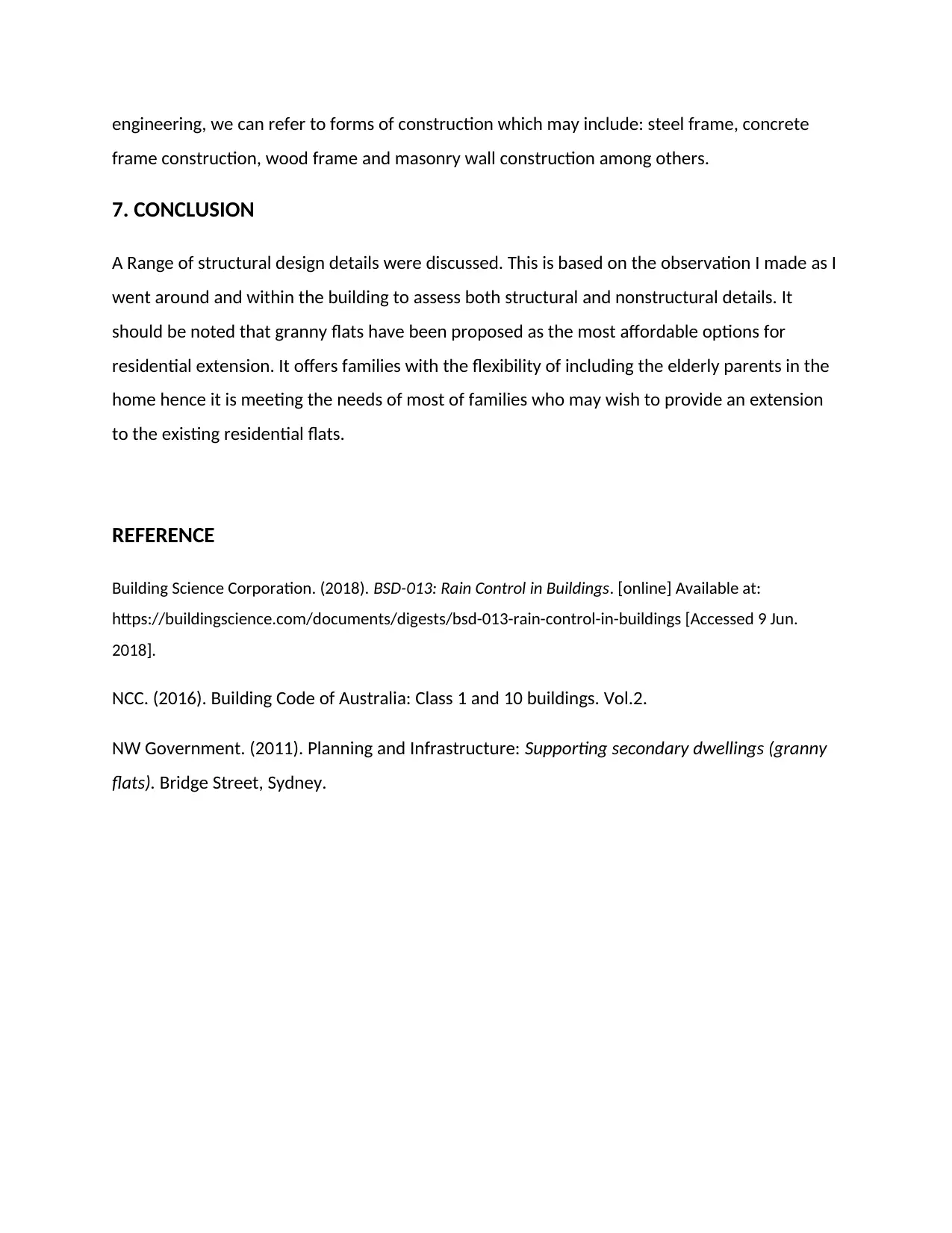
engineering, we can refer to forms of construction which may include: steel frame, concrete
frame construction, wood frame and masonry wall construction among others.
7. CONCLUSION
A Range of structural design details were discussed. This is based on the observation I made as I
went around and within the building to assess both structural and nonstructural details. It
should be noted that granny flats have been proposed as the most affordable options for
residential extension. It offers families with the flexibility of including the elderly parents in the
home hence it is meeting the needs of most of families who may wish to provide an extension
to the existing residential flats.
REFERENCE
Building Science Corporation. (2018). BSD-013: Rain Control in Buildings. [online] Available at:
https://buildingscience.com/documents/digests/bsd-013-rain-control-in-buildings [Accessed 9 Jun.
2018].
NCC. (2016). Building Code of Australia: Class 1 and 10 buildings. Vol.2.
NW Government. (2011). Planning and Infrastructure: Supporting secondary dwellings (granny
flats). Bridge Street, Sydney.
frame construction, wood frame and masonry wall construction among others.
7. CONCLUSION
A Range of structural design details were discussed. This is based on the observation I made as I
went around and within the building to assess both structural and nonstructural details. It
should be noted that granny flats have been proposed as the most affordable options for
residential extension. It offers families with the flexibility of including the elderly parents in the
home hence it is meeting the needs of most of families who may wish to provide an extension
to the existing residential flats.
REFERENCE
Building Science Corporation. (2018). BSD-013: Rain Control in Buildings. [online] Available at:
https://buildingscience.com/documents/digests/bsd-013-rain-control-in-buildings [Accessed 9 Jun.
2018].
NCC. (2016). Building Code of Australia: Class 1 and 10 buildings. Vol.2.
NW Government. (2011). Planning and Infrastructure: Supporting secondary dwellings (granny
flats). Bridge Street, Sydney.
1 out of 8
Related Documents
Your All-in-One AI-Powered Toolkit for Academic Success.
+13062052269
info@desklib.com
Available 24*7 on WhatsApp / Email
![[object Object]](/_next/static/media/star-bottom.7253800d.svg)
Unlock your academic potential
Copyright © 2020–2025 A2Z Services. All Rights Reserved. Developed and managed by ZUCOL.




